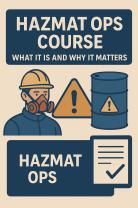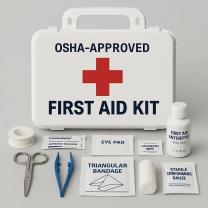What is the fire safety training module?
A fire safety training module is a structured educational program designed to teach individuals about fire safety, emergency response procedures, and preventive measures in the event of a fire. The module typically includes various components to ensure comprehensive coverage of fire safety topics. While the specific content may vary, here are common components found in a fire safety training module:
Introduction:
- Overview of the importance of fire safety training.
- Explanation of the potential consequences of fire incidents.
- Introduction to the organization's commitment to safety.
Legal and Regulatory Requirements:
- Information about local, state, and national regulations related to fire safety.
- Explanation of the organization's compliance with relevant laws.
Fire Triangle and Fire Tetrahedron:
- Explanation of the fire triangle (fire needs fuel, oxygen, and heat) and fire tetrahedron (adds a chemical reaction).
- Understanding the conditions required for a fire to occur.
Common Causes of Fires:
- Identification of common fire hazards in the workplace.
- Examples of potential ignition sources and flammable materials.
Fire Prevention Measures:
- Best practices for preventing fires in the workplace.
- Maintenance and inspection procedures for electrical equipment.
- Proper storage of flammable materials.
Fire Extinguishers:
- Overview of the types of fire extinguishers and their uses.
- Explanation of the PASS (Pull, Aim, Squeeze, Sweep) technique for using a fire extinguisher.
Evacuation Procedures:
- Detailed evacuation routes and exit locations.
- Protocols for evacuating the building during a fire.
- Assembly points and roll call procedures.
Emergency Communication:
- Procedures for reporting a fire or emergency.
- Communication systems and emergency contacts.
Emergency Response Team Roles:
- Introduction to roles and responsibilities of individuals in the emergency response team.
- Coordination and communication among team members.
Smoke Detection and Alarms:
- Importance of smoke detectors and fire alarms.
- Testing and maintenance procedures for alarms.
Emergency Drills:
- Explanation of the purpose of fire drills.
- Scheduling and participation in fire evacuation drills.
First Aid and Medical Assistance:
- Basic first aid measures for injuries related to fires.
- Procedures for summoning medical assistance.
Crisis Management and Leadership:
- Guidelines for crisis management during a fire.
- Leadership responsibilities during an emergency.
Post-Fire Procedures:
- Protocols for assessing damages after a fire.
- Reporting and documenting incidents for investigation.
Review and Assessment:
- Recap of key fire safety concepts.
- Knowledge assessment through quizzes or tests.
Documentation and Record-Keeping:
- Importance of documenting fire safety training.
- Maintenance of records related to drills and employee participation.
Resources and References:
- Distribution of relevant resources, such as fire safety manuals and guidelines.
- Reference materials for ongoing learning.
Feedback and Improvement:
- Collection of feedback from participants.
- Continuous improvement of the fire safety training module based on feedback and changing circumstances.
A well-designed fire safety training module is interactive, engaging, and tailored to the specific needs of the organization and its workforce. Regular updates and refresher training sessions ensure that employees stay informed and prepared to respond effectively in the event of a fire.
What are the key components of a fire safety training module?
An effective fire safety training module should cover several key components to equip employees with comprehensive knowledge and practical skills for fire prevention and response in the workplace. Here are some essential elements:
1. Fire awareness and prevention:
- Understanding fire hazards: Familiarize employees with common fire hazards present in the workplace, such as electrical equipment, flammable materials, and unattended cooking appliances.
- Fire prevention practices: Train employees on safe work practices to minimize fire risks, like proper storage of flammable materials, safe disposal of combustible waste, and maintaining electrical equipment.
- Early warning systems: Explain the different types of fire detection and alarm systems in the building and how to respond to them (e.g., evacuate immediately, report the fire).
2. Emergency response and evacuation procedures:
- Evacuation plan review: Thoroughly explain the building's evacuation plan, including designated evacuation routes, exits, and assembly points.
- Drill simulations: Conduct realistic evacuation drills to familiarize employees with the actual evacuation process and address any confusion or uncertainty.
- Buddy system and assistance: Encourage the use of a buddy system during evacuation to ensure everyone leaves safely and account for any missing individuals.
3. Fire extinguisher training:
- Different types of extinguishers: Introduce the different types of fire extinguishers available and explain their appropriate use based on the type of fire (e.g., Class A for paper and wood, Class B for flammable liquids).
- Hands-on practice: Provide hands-on practice with fire extinguishers using simulated fire scenarios. This allows employees to overcome initial hesitation and gain confidence in using the equipment effectively.
- Maintenance and inspection: Discuss the importance of proper extinguisher maintenance and how to identify potential malfunctions.
4. Additional important topics:
- Workplace communication: Emphasize the importance of clear communication during a fire emergency, including alerting others and reporting the fire to the appropriate authorities.
- Use of alternative escape routes: Discuss alternative escape routes in case primary exits are blocked, such as stairwells or windows.
- Special considerations for specific roles: Address specific procedures and responsibilities for employees in high-risk roles or those with disabilities.
Remember:
- Interactive and engaging training: Utilize engaging methods like videos, quizzes, group discussions, and interactive activities to keep participants engaged and retain information.
- Regular refreshers: Conduct regular fire safety refresher training to reinforce knowledge and ensure continued preparedness.
- Workplace-specific content: Tailor the training content to address the specific fire hazards and risks present in your workplace environment.
By incorporating these key components, you can design a comprehensive fire safety training module that effectively equips your employees with the knowledge and skills necessary to prevent, respond to, and stay safe in case of a fire emergency.













